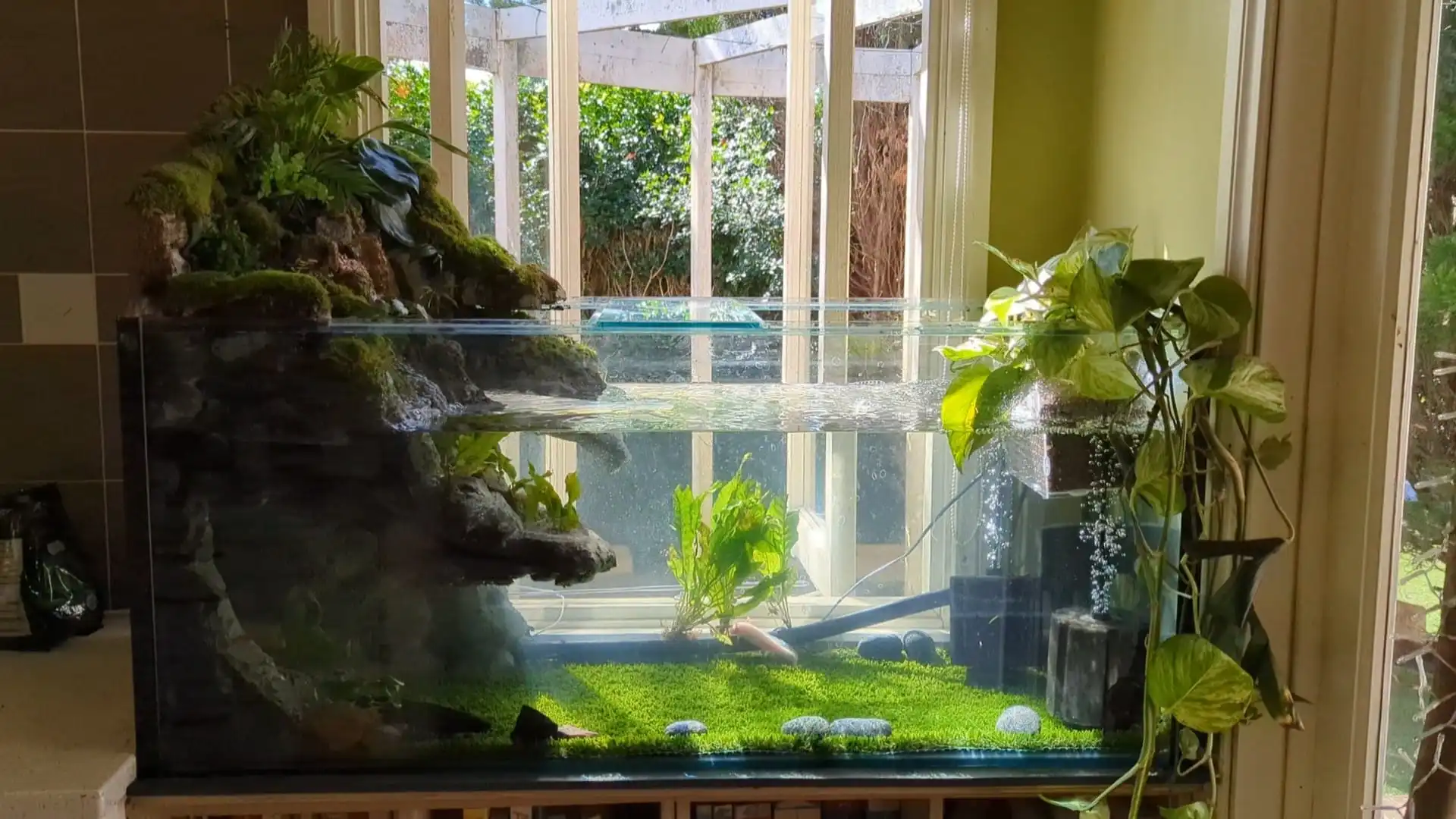For a healthy axolotl tank, filters are a must. They host beneficial bacteria, stabilize water chemistry, and help in oxygenation.
Axolotl creates a lot of mess in the tank, and apart from spot cleaning, you need a good filter. They are also sensitive to water quality, strong currents, and loud pumps can stress them.
A sponge filter fixes most of that. There’s low flow, gentle filtration, and a safe place for beneficial bacteria to grow.
Here, I’ll explain the simple why and how. You’ll learn how sponge filters work compared to hang-on-back or canister setups, how to pick the right size for your tank, and how to keep oxygen high without blasting current.
I’ll also cover common problems like clogging and noise, and give practical fixes you can do today. Let’s start!
Table of Contents
What is a Sponge Filter and How It Helps Your Axolotl
Sponge filters are the simplest type of tank filters that offer mechanical and biological filtration. They are made of a porous foam sponge connected to a lift tube and driven by an air pump. The rising air creates a gentle upward flow. It pulls water through the sponge where solids are trapped, and bacteria break down toxic waste.
The main components are:
- Sponge: A porous sponge inside the tank to collect debris and provide a surface area for the bacterial colony to grow.
- Air Pump: Present outside the tank. Pumps air through the tube, and creates bubbles that rise through the sponge.
- Tubing: Connects the air pump to the sponge.
- Weightless Base: The sponge fits on top of a weightless base or suction cups on the bottom of the filter. It keeps the filter steady in the tank.
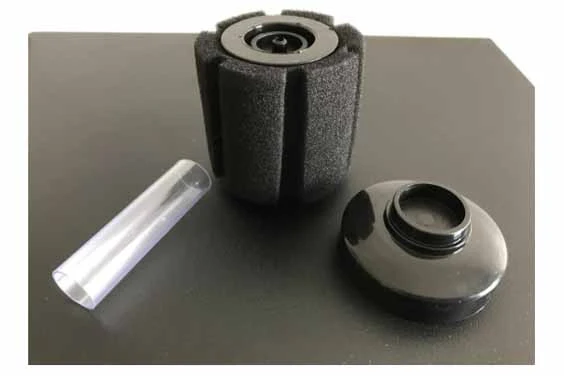
Here’s how they connect and function together:
An air pump pushes air through the airline tube into the sponge filter. This creates air bubbles to rise and uplift the tube, pulling water along with them. The upward flow of water creates a vacuum, causing more water to rush into the porous foam sponge.
As water passes through the sponge, it traps debris, dirt, fish poop, decaying plants, and uneaten food.
Also, the sponge surface offers a growth medium for beneficial bacteria. These bacteria convert harmful waste products into safe substances and provide biological filtration.
Filtered water passes through the top of the tube and goes back into the tank.
How Sponge Filters Keep Your Axolotl’s Water Clean
Mechanical Filtration
The sponge physically traps bits of poop and uneaten food. The solids won’t break down into ammonia inside the water column. Mechanical filtration alone is useful, but not enough. You still need the biological action the sponge supports.
Biological Filtration
Beneficial nitrifying bacteria colonize the sponge surface. Nitrosomonas converts ammonia to nitrite, and Nitrobacter converts nitrite to nitrate.
This chain is the nitrogen cycle: Ammonia -> Nitrite -> Nitrate. You need to keep this cycle stable, as it directly affects your tank water parameters.
Here’s how bacteria colonize the sponge:
- Bacteria arrive from water, substrate, and decorations.
- They grow on the porous surfaces where water brings oxygen and food (waste).
- A larger, porous sponge equals more bacteria and processing capacity.
Axolotls are high bio-load animals. They produce a lot of waste. So you need both mechanical and strong biological filtration that does not create a strong flow.
Oxygenation and Water Movement
A stable water current is essential to improve the oxygen supply and distribute it evenly throughout the tank.
Sponge filters produce bubbles as a part of their filtration process. Bubbles rise through the lift tube and create a suction effect. They allow gentle water movement and improve the amount of surface agitation. It facilitates gas exchange at the surface.
The uniform release of bubbles facilitates a continuous current in the water. Thus, prevent stagnant and dead zones and provide optimum levels of dissolved oxygen.
Benefits for Axolotls
- Ultra-Low Flow: Sponge filters make a very gentle current. It reduces gill stress and keeps axolotls calm. There is a control flow valve, too, that helps to adjust the filter.
- Safety: There are no exposed impellers or intake tubes that can trap tiny limbs or gills. So, exceptionally safe for hatchlings and juveniles.
- Simple Maintenance: Cleaning is simple. Rinse the sponge in tank water during a water change to remove trapped debris and keep most bacteria intact.
- Cost-Effective and Durable: They are inexpensive and last a long time. There are different available sizes too.
Different Types of Sponge Filters
Sponge filters come in different sizes and designs. The primary purpose and working mechanism are the same, though.
- Single vs. Dual: A single sponge is the most basic filter. There is one foam, and the dual sponge has two separate foams, with more filtering capacity. The dual filters are recommended for better filtration. They provide more surface area for bacteria and have an adjustable flow rate to control water currents.
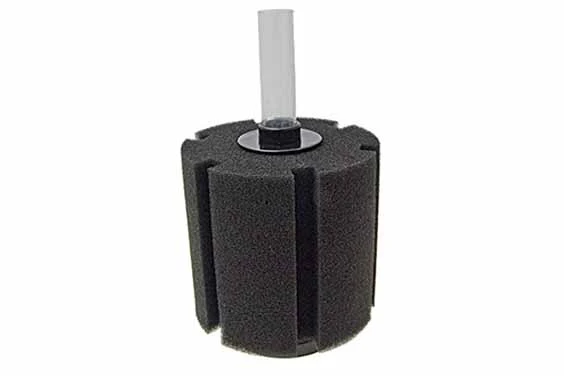
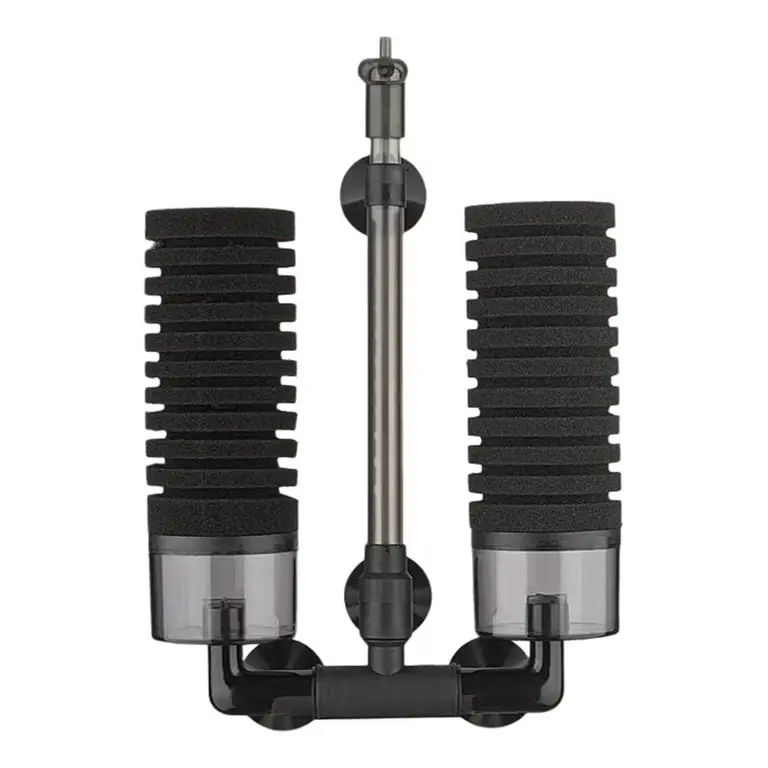
- Hanging vs. Standing: Hanging filters attach to the back of the tank, and the sponge is suspended inside the water. In contrast, standing filters sit at the bottom of the tank.
- Air-Driven Sponge Filters: They use an air pump to regulate water flow through the sponge. They are simple to use but require regular maintenance for efficient filtration.
- Submersible Sponge Filters: They just sit in the tank and work without an air pump.
- Coarse vs. Fine Sponge: Fine-pore sponges help eliminate fine particles from the water, but they are hard to clean and can easily get clogged. A coarse sponge is preferred because it is porous but easy to clean.
My Recommended Sponge Filter
Hygger Double Sponge Filter
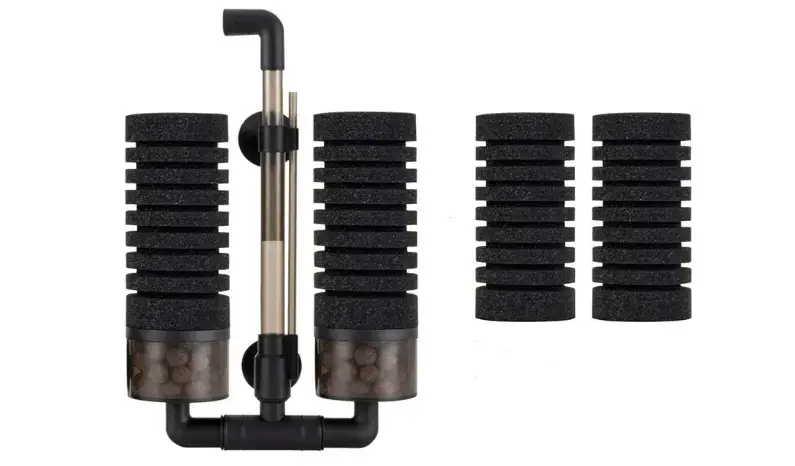
I use a Hygger aquarium double sponge filter for a 42-gallon tank. The filters come in multiple sizes, bio balls, and extra sponges. It does a great job and maintains the water quality. Plus, it is easy to assemble and maintain. The water flow is gentle for Lucy, as she seems to like it, and bubbles help to oxygenate the water.
Upettools Aquarium Air Stone
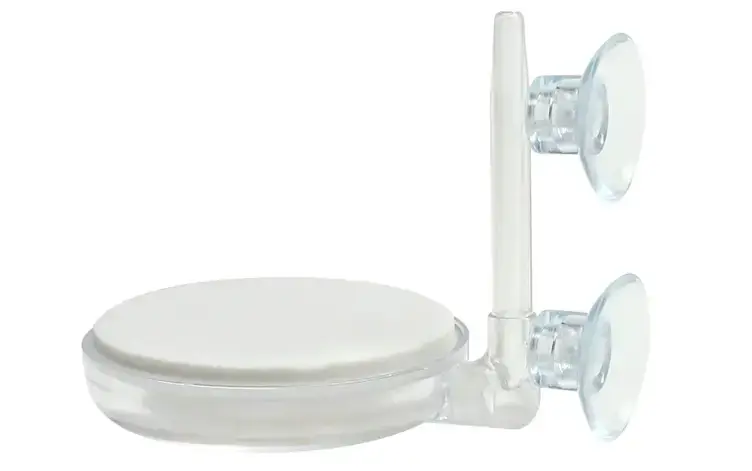
I use a sponge filter in combination with Upettools Aquarium Air Stone for better efficiency. It helps with better aeration and reduces surface disturbance. It was a nice purchase and worth the money for small systems.
How to Set Up Your Axolotl’s Sponge Filter
Setting up the sponge filter is simple, as it consists of only a few components to assemble.
- Slide the sponge over the plastic tube. Attach all the tubes using connectors.
- Attach the air tube to the first part at the bottom of the plastic tube (strainer).
- Attach the strainer to the weightless base/suction cups and put the setup in the tank.
- Now, connect the other end of the air tube to the air pump. The air bubbles from the pump rise, and the water flows through the sponge and filters it.
Here are the steps for the Hygger sponge filter:
1. Unbox and Check the Sponge Filter
Open the package and inspect the filter’s components for any damage or missing parts. It must contain the following parts.
- The weightless base
- Suction cups (attached or separated)
- Two sponge cylinders
- Air intake nozzle
- The uplift tube (the clear tube that sticks up)
2. Rinse the Sponges
Rinse the sponges in dechlorinated water or old tank water to remove any factory residue or dust. Never use tap water or squeeze the sponge. Gentle cleaning is enough.
3. Assemble the Parts
Attach the sponges to the base or arm of the plastic/metal tube. Adjust the height of the uplift tube according to the tank depth. Connect the air intake nozzle to the uplift tube. And fill the ceramic media balls.
4. Cut and Attach the Airline Tubing
Cut a piece of airline tubing long enough to attach the air pump to the filter. Use connectors if needed.
Insert a check valve in the tubing to prevent water from flowing back into the air pump. Make sure the arrow points towards the filter.
Now, connect one end of the airline tubing to the air pump and the other end to the air intake nozzle on the sponge filter.
5. Place the Filter in the Tank
With the help of suction cups, stick the filter to the wall of the tank. Try to place them near a corner so it won’t disturb the axolotl too much.
In large tanks, place the filter closer to the center to help with even water flow.
6. Plug in the Air Pump
Now plug in the air pump, and you should see bubbles rising from both sponges. If only one side is bubbling, you should check the tubing or connections.
7. Monitor It
Let the filter run and inspect if the water is circulating gently.
Are there any loud noises or strong currents?
Are both sponges bubbling?
If all looks good, your filter is ready!
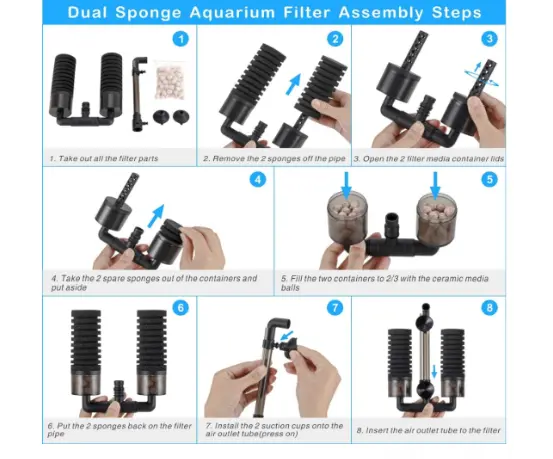
How to Maintain Your Sponge Filter
1. Rinse the Sponge
Sponge filters trap debris, dirt, and solid waste, which can lead to clogging. I usually clean it once a month, when the debris is visible or before water changes.
- To clean the sponge, remove the top parts of the filter to access the foam for cleaning.
- Put a cup in the tank and place the filter inside it. Lift the cup out, then squeeze the sponge into the cup to release the gunk. Pour the dirty water down the drain.
- Reassemble the filter and put it back in the tank.
2. Airflow and Oxygenation
Apart from cleaning, you should regularly check for kinks in the airline tubing. Bends or kinks can disrupt the airflow and reduce the oxygen flow and filtration efficiency.
To prevent this, you can reroute the tube or replace the tube with a new straight tube if the damage is severe.
3. Air Stones Maintenance
If you are using airstones, then monthly inspect them as they get clogged. Detritus, mineral deposits, and plastic from molding can accumulate on the air stone surface and inside the pores.
Also Read: Best Live Plants for Your Axolotl Tank
Troubleshoot Common Sponge Filter Issues
1. Issue: Low or No Airflow
A decrease or low airflow, a reduction in bubble flow, and slower water circulation. Also, if you notice solid particles floating around the water, it means the filter is not working efficiently.
Possible Causes:
- Blocked or Kinked Tube.
- Clogged air stone.
- Weak air pump.
- Check the valve.
Solutions:
- Replace or reroute the tubing.
- Clean or replace the air stone.
- Check tubing.
- Verify check valve direction and function.
2. Issue: Filter is Noisy
Although sponge filters work well for biofiltration, sometimes they produce a gurgling noise due to bubble formation. The majority of people find this sound disruptive and annoying.
Possible Causes:
- Vibrating air pump.
- The filter rattling against the tank.
- Large bubbles.
Solutions:
- Place the pump on a soft surface and secure the filter base.
- Use an air stone/air collar for finer bubbles.
- Adjust the airflow with a valve.
- Use a lid.
3. Issue: Water Parameters Spiking (Ammonia/Nitrite)
Ammonia and nitrite spikes are not common in established tanks. However, if you observe that, it means there are not enough bacteria to break down the waste.
Possible Causes:
- The tank is not fully cycled.
- Overfeeding.
- Increased bioload.
- Over-cleaning of filter media can harm bacterial colonies.
- Poor water quality.
Solutions:
- Test the water and perform a water change accordingly.
- Reduce feeding.
- Check and clean the filter correctly.
- Have adequate airflow.
- Recycle the tank if the issue persists.
4. Issue: Filter Keeps Tipping Over
A sponge filter won’t stick to the tank due to multiple factors.
Possible Causes:
- Insufficient weighted base.
- Improper suction cup alignment.
- Strong axolotl activity.
- Trapped air in the sponge can cause it to float.
Solutions:
- Check the base is clean and making good contact.
- Use a heavier filter.
- Secure with aquarium-safe weights and strong suction cups.
How to Select the Right Air Pump or Air Stone
Axolotls are sensitive to strong vibrations and noise. So, a quiet pump is beneficial. Look for the pumps that are specifically marketed as “low vibration”. Always do your research before investing in a new product.
1. Airflow Control
Your goal is oxygenated water without stressing your axolotl. A flow control valve helps you to adjust or regulate the amount of air pumped into the sponge filter. The airflow control for water movement in the tank eventually improves the oxygenation.
2. The Non-Negotiable Check Valve
Check valves, also known as non-return valves, help airflow in one direction and prevent the opposite flow. It prevents water from siphoning into the pump in case of power failure. It’s a precautionary measure, as in the worst scenario, an electrical shock can happen when the pump restarts.
3. Tubing and Connectors
Standard airline tubing is used to connect the air pump to the sponge filter. T-connectors are used to split the air tubing to connect one end to the sponge filter and the other to the air pump. Whereas, L-connectors are used to route the airline tube and prevent interference.
Some Tips You Must Remember
- For larger tanks, consider two sponge filters to increase biological filtration.
- Place the filter near a wall or in a corner to decrease water disturbance on the surface.
- Cycle your tank with a sponge filter before adding the axolotl.
- If tank parameters (ammonia, nitrites) suddenly spike, immediately check the sponge filter for clogging or reduced airflow.
- Consider the total volume of your tank, bio load, and size/number of axolotls before selecting the sponge filter.
Also Read:
The Axolotl Diaries
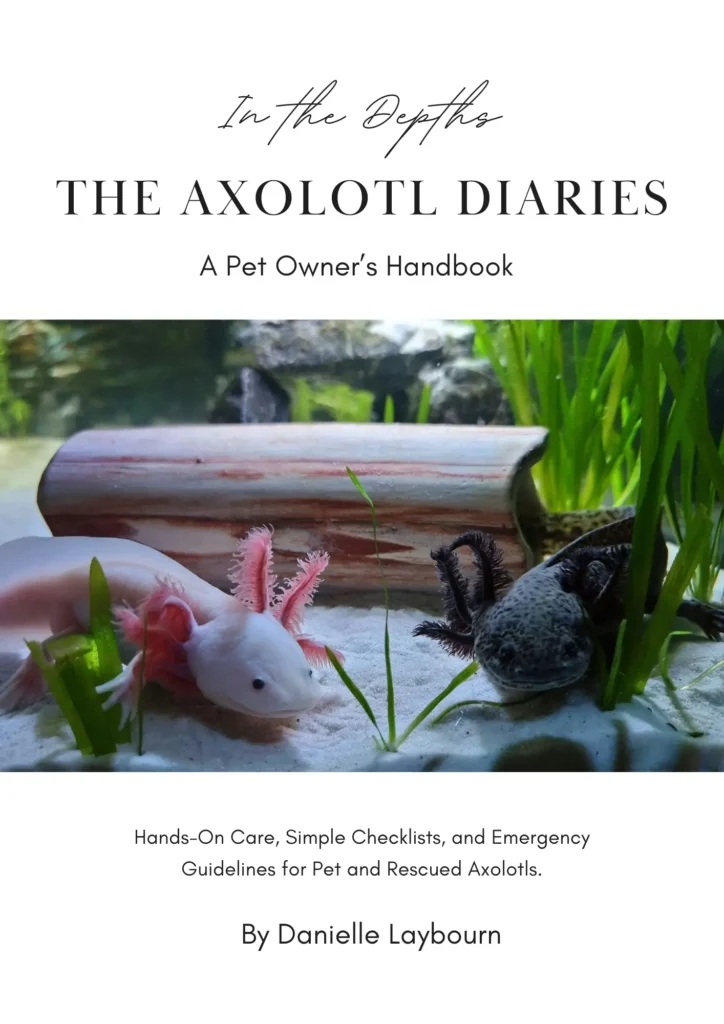
A clear, step-by-step handbook (50+ pages) about axolotl care that covers basics, safe tank requirements, cycling, feeding, common health issues, and more.
Rescue-informed and vet-aware. For anyone who wants to raise a healthy, happy axolotl.
Find everything in plain language, backed by real experience.
Grab printable cheatsheets, practical tips, and easy troubleshooting guide inside!
Price: $14.99
Summing Up
It’s very simple to set up your sponge filter once you understand the basics. Select the right size for your tank, connect it to a quiet air pump, and position it so the gentle flow reaches most of the water without disturbing your axolotl.
Let the sponge mature so beneficial bacteria can establish, and clean it only by rinsing in tank water during water changes.
And, you’ll have clear, well-oxygenated water, a stable nitrogen cycle, and a calm environment that keeps your axolotl healthy and stress-free!
Disclosure: This post contains affiliate links. As an Amazon Associate, I earn from qualifying purchases. It means that if you click on an Amazon link on this site and make a purchase, I may earn a small commission at no extra cost to you. Thank you for your support!
